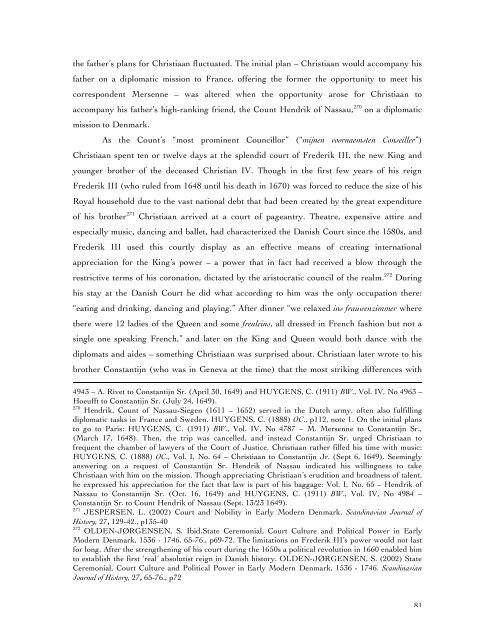Christiaan Huygens – A family affair - Proeven van Vroeger
Christiaan Huygens – A family affair - Proeven van Vroeger
Christiaan Huygens – A family affair - Proeven van Vroeger
You also want an ePaper? Increase the reach of your titles
YUMPU automatically turns print PDFs into web optimized ePapers that Google loves.
the father’s plans for <strong>Christiaan</strong> fluctuated. The initial plan <strong>–</strong> <strong>Christiaan</strong> would accompany his<br />
father on a diplomatic mission to France, offering the former the opportunity to meet his<br />
correspondent Mersenne <strong>–</strong> was altered when the opportunity arose for <strong>Christiaan</strong> to<br />
accompany his father’s high-ranking friend, the Count Hendrik of Nassau, 270 on a diplomatic<br />
mission to Denmark.<br />
As the Count’s “most prominent Councillor” (“mijnen voornaemsten Conseiller”)<br />
<strong>Christiaan</strong> spent ten or twelve days at the splendid court of Frederik III, the new King and<br />
younger brother of the deceased Christian IV. Though in the first few years of his reign<br />
Frederik III (who ruled from 1648 until his death in 1670) was forced to reduce the size of his<br />
Royal household due to the vast national debt that had been created by the great expenditure<br />
of his brother 271 <strong>Christiaan</strong> arrived at a court of pageantry. Theatre, expensive attire and<br />
especially music, dancing and ballet, had characterized the Danish Court since the 1580s, and<br />
Frederik III used this courtly display as an effective means of creating international<br />
appreciation for the King’s power <strong>–</strong> a power that in fact had received a blow through the<br />
restrictive terms of his coronation, dictated by the aristocratic council of the realm. 272 During<br />
his stay at the Danish Court he did what according to him was the only occupation there:<br />
“eating and drinking, dancing and playing.” After dinner “we relaxed ins frauwenzimmer where<br />
there were 12 ladies of the Queen and some freuleins, all dressed in French fashion but not a<br />
single one speaking French,” and later on the King and Queen would both dance with the<br />
diplomats and aides <strong>–</strong> something <strong>Christiaan</strong> was surprised about. <strong>Christiaan</strong> later wrote to his<br />
brother Constantijn (who was in Geneva at the time) that the most striking differences with<br />
4943 <strong>–</strong> A. Rivet to Constantijn Sr. (April 30, 1649) and HUYGENS, C. (1911) BW., Vol. IV, No 4963 <strong>–</strong><br />
Hoeufft to Constantijn Sr. (July 24, 1649).<br />
270<br />
Hendrik, Count of Nassau-Siegen (1611 <strong>–</strong> 1652) served in the Dutch army, often also fulfilling<br />
diplomatic tasks in France and Sweden. HUYGENS, C. (1888) OC., p112, note 1. On the initial plans<br />
to go to Paris: HUYGENS, C. (1911) BW., Vol. IV, No 4787 <strong>–</strong> M. Mersenne to Constantijn Sr.,<br />
(March 17, 1648). Then, the trip was cancelled, and instead Constantijn Sr. urged <strong>Christiaan</strong> to<br />
frequent the chamber of lawyers of the Court of Justice. <strong>Christiaan</strong> rather filled his time with music:<br />
HUYGENS, C. (1888) OC., Vol. I, No. 64 <strong>–</strong> <strong>Christiaan</strong> to Constantijn Jr. (Sept 6, 1649). Seemingly<br />
answering on a request of Constantijn Sr. Hendrik of Nassau indicated his willingness to take<br />
<strong>Christiaan</strong> with him on the mission. Though appreciating <strong>Christiaan</strong>’s erudition and broadness of talent,<br />
he expressed his appreciation for the fact that law is part of his baggage: Vol. I, No. 65 <strong>–</strong> Hendrik of<br />
Nassau to Constantijn Sr. (Oct. 16, 1649) and HUYGENS, C. (1911) BW., Vol. IV, No 4984 <strong>–</strong><br />
Constantijn Sr. to Count Hendrik of Nassau (Sept. 13/23 1649).<br />
271<br />
JESPERSEN, L. (2002) Court and Nobility in Early Modern Denmark. Scandinavian Journal of<br />
History, 27, 129-42., p135-40<br />
272<br />
OLDEN-JØRGENSEN, S. Ibid.State Ceremonial, Court Culture and Political Power in Early<br />
Modern Denmark, 1536 - 1746. 65-76., p69-72. The limitations on Frederik III’s power would not last<br />
for long. After the strengthening of his court during the 1650s a political revolution in 1660 enabled him<br />
to establish the first ‘real’ absolutist reign in Danish history. OLDEN-JØRGENSEN, S. (2002) State<br />
Ceremonial, Court Culture and Political Power in Early Modern Denmark, 1536 - 1746. Scandinavian<br />
Journal of History, 27, 65-76., p72<br />
81


